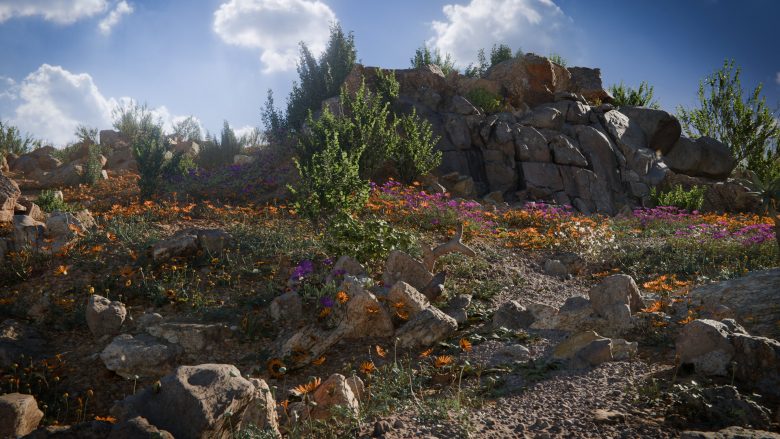blog.polyhaven.com
Download the scene fileBrowse the assetsAfter more than a year in the making, were finally happy to share our latest asset collection: Namaqualand!Browse the assetsMicro-biomes of South Africa (Source)In September 2023, the Poly Haven team embarked on a journey to the arid desert near the West coast of South Africa specifically to the Goegap Nature Reserve.For a handful of weeks in the year, what is usually a dry and sandy landscape scarred by mining activity transforms into a floral paradise following the spring rains.While we chose this location in the hopes that the sparse desert would be a unique but manageable scanning project, we couldnt pass up the opportunity to try to capture what even local adventurers rarely get to see.As luck would have it, we nailed the timing and saw the landscape covered in innumerable flowers.Jenelle, James, Dario, Jarod, GregAfter surviving the 12-hour drive from Joburg and resting for the night, we kicked off the project with a scouting hike on the first morning to get the lay of the land and begin prioritizing what we needed to capture.That evening, after a gorgeous sunset, we sat down and planned the rest of the week.We were told that the lodgings were completely without electricity, so we came prepared with many spare batteries for all our cameras and flashes, power banks, a small solar-charged battery, and some adapters to charge devices using our 44 SUV as a generator.In the end, though, our unit had a small solar system that provided just enough power to run the fridge and charge our camera gear. We still had to use this sparingly and try to charge as much as possible during the day.While much of the photoscanning happened in the field (literally), we also brought many of the smaller rocks and other debris into a spare bathroom, where we had assembled a black velvet backdrop to scan against with a turntable.With the combination of a black velvet backdrop and a cross-polarized ring flash setup, we can scan objects in the void, producing very high-quality geometry and surface textures with minimal data preprocessing.The ring flash setup, however, is not powerful enough to scan outdoors in direct sunlight, which, of course, is plentiful in the desert.So, we also brought with us our Elinchrom ELB 500 rig, which is strong enough to overpower the sun and also significantly more ergonomic than our ring flash.The final photogrammetry rig we utilized is a motorized single-axis gantry that, in combination with the ring flash, partially automates scanning a 2-3 meter wide area and removes some of the potential for human error.While certainly not necessary, we wanted to test it out before our trip to #TheMoon, which couldnt be scanned any other way and indeed proved invaluable.Its no surprise to anyone that trying to scan plants with photogrammetry is usually futileThis aint gonna work.So, we also captured many photometric stereo scans from plant debris.Most of the plant assets were then created dynamically with Blenders geometry nodes, using a combination of various scan data, references, and many months of hard work.All in all, were very proud of what weve achieved here and the scope of assets that we managed to capture and reproduce. Were happy to share a small slice of our home country with you, and hope that you make something beautiful with our work We learned a lot in the process, both about scanning in the field, how to better prepare next time, and how to process the data and build the assets more efficiently.It may yet be some time before we take on another nature biome project, knowing how much work this has been and how the next one is likely to be even more ambitious. But in the meantime, we have a number of other projects cooking, so stay tuned to this blog and join our Discord to come along on our journey with us.




